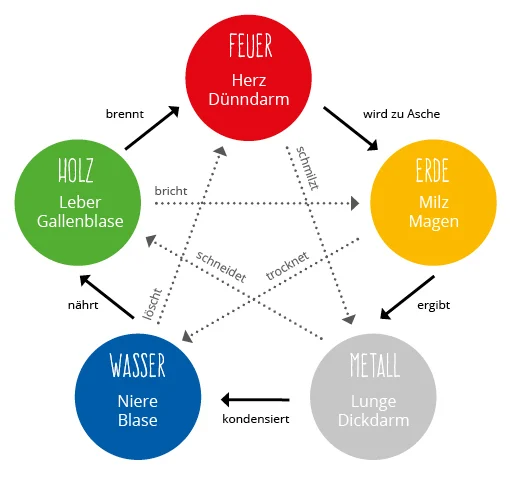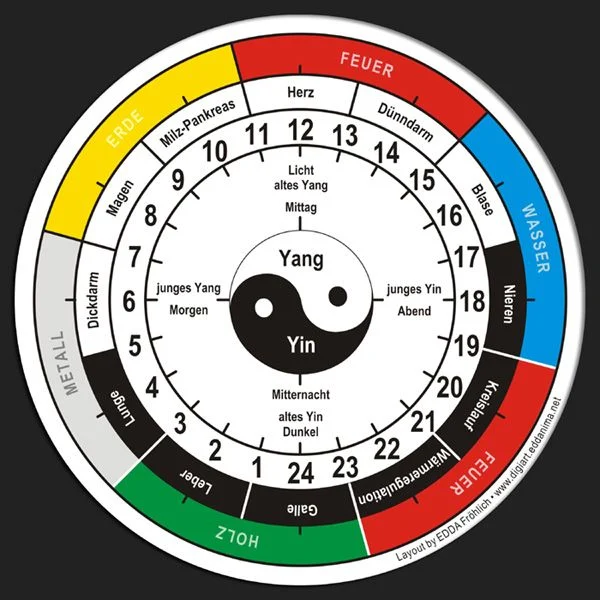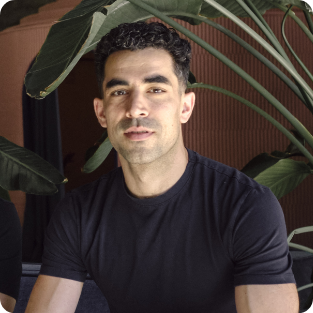
- Introduction: What is TCM?
Traditional Chinese Medicine (TCM) is a healing system with a history stretching back over 2,000 years. It views the body, mind, and environment as an inseparable whole. Unlike many modern therapeutic approaches, TCM treatments do not merely aim to suppress isolated symptoms but instead focus on restoring the harmonious balance of the body’s vital energy—known as Qi—which flows through the body along defined pathways called meridians.
Core concepts such as Yin and Yang and the Five Element Theory serve as diagnostic frameworks for identifying imbalances at an early stage and correcting them in a targeted manner. The objective of TCM therapy is not only to relieve acute discomfort, but also to activate the body’s natural self-healing mechanisms over the long term and prevent illness before it arises.


Visualization of the core components of Traditional Chinese Medicine: Qi, Yin-Yang balance, Five Elements, Meridians
At a time when more people are seeking sustainable, holistic solutions to health problems, Chinese medicine is gaining growing recognition in the Western world. With a strong emphasis on prevention, personalization, and natural methods, TCM offers a scientifically grounded alternative to purely symptom-oriented treatment approaches—as highlighted in the WHO Global Report on Traditional and Complementary Medicine 2019 and in Paul U. Unschuld’s authoritative work on Traditional Chinese Medicine.
One of the most prominent areas of focus is TCM acupuncture—a therapeutic method that regulates energy flow within the body. Clinical studies have shown its effectiveness in treating chronic pain, stress-related conditions, and a variety of other ailments.
In the next chapter, we take a step back in time: How did Traditional Chinese Medicine originate—and why is it still relevant today?
- The History of TCM and Its Modern Relevance
The roots of Traditional Chinese Medicine (TCM) extend back more than 2,000 years. Its earliest written documentation appears in the Huangdi Neijing—the Yellow Emperor’s Classic of Internal Medicine—a foundational text that continues to shape TCM today. This influential work is explored in depth in publications such as Leitfaden Chinesische Medizin by Claudia Focks and Norman Hillenbrand.
During this early period, health was understood as a dynamic harmony between the individual, nature, and the cosmos. Over the centuries, TCM underwent continuous refinement. Successive Chinese dynasties contributed to the evolution of diagnostic methods, therapeutic principles, and pharmacological knowledge. In particular, the systematic categorization of medicinal herbs and the advancement of acupuncture techniques played a defining role in shaping clinical practice.
With China’s gradual opening to the world in the 20th century, TCM entered the realm of global scientific discourse. Institutions such as the World Health Organization (WHO) now officially recognize several TCM methods as effective complements to conventional medicine, as documented in the Global Report on Traditional and Complementary Medicine 2019.
Modern research increasingly investigates the efficacy of acupuncture, herbal medicine, and related TCM modalities in addressing chronic illnesses and pain management. Simultaneously, TCM is being adopted within Western healthcare systems. Today, many clinics and medical practices integrate acupuncture, nutrition counseling based on TCM principles, and other complementary therapies into patient care.
In Switzerland, for example, leading institutions and health insurers such as Helsana now offer TCM-based services—often embedded within integrated, patient-centered care models. This modern implementation combines traditional healing philosophy with scientific diagnostics and opens up new pathways for sustainable healthcare delivery. As Paul U. Unschuld notes in his article on Spektrum.de, TCM is currently experiencing a remarkable resurgence in the West—driven by a growing demand for holistic and personalized approaches to health.
This historical depth—combined with contemporary scientific validation and successful integration into modern care systems—makes TCM a relevant and timely option for individuals seeking a holistic yet evidence-informed path to well-being.
In the next chapter, we explore how TCM actively supports healing in both body and mind—and why this connection is essential for lasting health.
- How TCM Heals the Body and Mind
Traditional Chinese Medicine (TCM) views health as the result of a harmonious balance between body, mind, and the surrounding environment—a perspective thoroughly explained in classical texts such as The Foundations of Chinese Medicine by Giovanni Maciocia.
At the core of this holistic concept are the principles of Yin and Yang, Qi, and the Five Elements.
Yin and Yang represent opposing yet interconnected forces—such as day and night, or activity and rest. Health arises when these two energies remain in balance within the body. An excess or deficiency of one side can lead to discomfort or illness.
Qi (pronounced “chee”) refers to the vital life energy that flows through the body along invisible channels known as meridians. When the flow of Qi is blocked or disrupted, symptoms such as fatigue, pain, or emotional imbalance may appear. Therapies like acupuncture or Qi Gong are designed to restore this energetic flow and dissolve blockages.
The Five Elements—Wood, Fire, Earth, Metal, and Water—link organs, emotions, and physiological functions to natural principles. For instance, the liver is associated with the Wood element and symbolizes flexibility and regenerative strength. This Five Element theory also plays a central role in TCM nutrition, where specific foods are used strategically to strengthen organs and restore energetic balance.
In addition, the so-called Organ Clock considers the times of day when certain organs are particularly active. For example, the kidney meridian is most active between 5 p.m. and 7 p.m.—a time in TCM that is used specifically to support regeneration and detoxification. Common complaints like spleen-related cramping, for instance, may be interpreted through the lens of a weakened spleen meridian, which also follows specific activity phases. This knowledge allows for precise therapy planning based on the body’s natural biorhythms, as clearly illustrated in Kursbuch Traditionelle Chinesische Medizin by Johannes Greten.
This systemic understanding enables TCM practitioners not only to treat symptoms, but also to identify and address underlying causes—whether they stem from stress, imbalanced nutrition, or emotional strain. The approach bridges traditional observational methods with modern diagnostics and a deep, empathetic view of the individual as a whole.
But just how effective are these millennia-old principles?
Numerous recent studies, summarized in sources such as the Global Report on Traditional and Complementary Medicine 2019 by the WHO, provide scientific insights into the efficacy of TCM practices such as acupuncture, herbal medicine, and nutritional counseling based on TCM principles.
In the next chapter, we will examine the latest research findings—and show how Traditional Chinese Medicine, modern biomedicine, and evidence-based approaches are increasingly working in unison.
- Scientific Research on TCM
The effectiveness of Traditional Chinese Medicine (TCM) is increasingly being confirmed by scientific studies. In Switzerland and around the world, a growing body of research supports TCM as a valuable complement to modern medicine.
A major investigation by the World Health Organization (WHO), the Global Report on Traditional and Complementary Medicine 2019, analyzed the available evidence on various TCM practices. One of its key findings was that acupuncture yields significantly better results than placebo treatments in managing chronic pain—including conditions like migraine, back pain, and osteoarthritis.
A meta-analysis published in the Journal Pain—drawing on data from the German Acupuncture Trials (GERAC) by Endres et al.—also concluded that acupuncture is an effective treatment method for chronic pain, demonstrating measurable benefits over sham procedures.
In Switzerland, the University of Zurich conducted a systematic review on the use of TCM for allergies and respiratory diseases. Researchers found that herbal therapies and acupuncture, in particular, showed notable improvements in cases of hay fever and chronic bronchitis—both in terms of symptom relief and patient quality of life.
Another Swiss study, published in Swiss Medical Weekly, investigated the use of TCM as a complementary approach in cancer care. The findings revealed that supportive acupuncture and herbal treatments significantly alleviated side effects such as nausea, fatigue, and pain during chemotherapy. This underlines TCM’s role as an integrative component in holistic oncology.
Additionally, a randomized controlled trial published in the British Medical Journal (BMJ) demonstrated that acupuncture can effectively reduce symptoms of depression—especially in patients seeking complementary or alternative approaches to treatment.
A study by Shang et al. further examined placebo-controlled trials on Chinese herbal medicine. While the results varied depending on the condition and formula, the overall findings were positive, indicating therapeutic potential for traditional remedies.
Taken together, these studies suggest that TCM is more than an ancient tradition—it is increasingly explored through evidence-based research and is finding a legitimate role within modern healthcare systems.
In the next chapter, we offer a practical overview of the most important TCM treatment methods—from acupuncture and herbal therapy to nutritional approaches.
5. Overview of TCM Treatment Methods
Traditional Chinese Medicine (TCM) offers a wide range of therapies tailored to the individual needs of each patient. These methods aim to restore balance between body and mind, alleviate symptoms, and activate the body’s innate healing capacity.
A compact introduction to key treatment modalities can be found in Einführung in die Chinesische Medizin by Fritz Friedl.
TCM Acupuncture: Targeted Activation of Energy Flow
TCM acupuncture is perhaps the best-known and most thoroughly researched method within Chinese medicine. Fine needles are inserted into specific points along the body’s meridians to regulate the flow of Qi, the vital life energy.
Studies published in journals such as the Journal of Pain confirm the effectiveness of acupuncture, particularly for chronic pain, stress, sleep disorders, and digestive complaints.
Chinese Herbal Medicine and Medicinal Mushrooms: Natural Regulation
This method uses a wide variety of plant-based, mineral, and animal substances combined according to individual needs. The aim is to correct internal imbalances and strengthen specific organs or bodily systems.
A systematic review by the University of Zurich found positive outcomes, particularly in treating respiratory conditions and allergies.
TCM Nutrition: Strengthening Health from Within
In TCM, nutrition is considered a fundamental pillar of health. Foods are classified by their energetic effects (e.g., warming, cooling, drying) and used to promote internal balance.
TCM-based nutritional counseling is especially helpful for digestive issues, fatigue, and preventing chronic illnesses.
Massage Chinois (Tuina Massage): Regeneration Through Energy Work
Tuina, often referred to as Massage Chinois, is a cornerstone of TCM therapy. This medical massage technique combines acupressure, mobilization, and meridian-based energy work.
Massage Chinois is especially effective for muscle tension, back pain, migraines, and stress-related conditions. Unlike traditional wellness massage, its therapeutic objectives include regulating Qi, relieving pain, and supporting the body’s self-healing process.
Additional Complementary TCM Therapies
Gua Sha Massage: Stimulates Lymphatic Flow
Gua Sha is a traditional scraping technique used to enhance circulation, promote lymphatic drainage, and relieve muscular tension.
Visual: Application of Gua Sha for muscle tension
Alt-Text: Gua Sha massage on the back to relieve muscle tightness
Cupping Therapy: Enhancing Blood Circulation
Cupping involves placing vacuum suction cups on the skin to stimulate blood flow, relieve pain, and support detoxification.
Shiatsu Massage: Holistic Balance
Shiatsu is a Japanese adaptation of meridian-based massage, commonly used for stress, exhaustion, and emotional imbalances.
Comparison Table of Major TCM Therapies
| Therapy | Primary Applications | Benefits |
| TCM Acupuncture | Pain, stress, sleep disorders | Rapid relief, targeted application |
| Herbal & Medicinal Mushroom Therapy | Chronic illness, immune weakness | Deep regulation, natural plant compounds |
| TCM Nutrition Counseling | Digestion, energy, prevention | Easy integration, long-lasting effects |
| Tuina Massage | Muscle tension, back pain, migraines | Regeneration through meridian therapy |
| Gua Sha | Detoxification, muscle tension | Stimulates blood and lymphatic flow |
| Cupping | Pain relief, detox | Enhances circulation |
| Shiatsu | Stress, emotional strain | Holistic emotional balance |
Each of these therapies can be applied independently or in combination to create a sustainable, personalized path to healing.
Modern adaptations of traditional methods—such as those described by Christian Schmincke in Chinesische Medizin für die westliche Welt—highlight the vast potential of TCM therapies within today’s healthcare systems.
In the next chapter, we explore how TCM treatments are provided in Switzerland and what quality criteria matter when choosing a qualified therapist.
6. Is TCM Right for You?
Traditional Chinese Medicine (TCM) offers a holistic approach to health and healing. But is it the right path for your personal health goals and lifestyle?
To support your decision, we’ve created a practical self-assessment checklist:
Checklist: Does TCM Align with Your Health Goals?
Answer the following questions honestly:
- Do you suffer from chronic conditions where conventional treatments have had limited success?
- Are you looking for a therapy that addresses body, mind, and emotions equally?
- Are you open to natural healing methods rooted in centuries-old tradition and supported by modern science?
- Are you willing to invest in your health and adjust your lifestyle—such as aligning with the body’s organ clock or focusing on the kidney meridian?
- Are you interested in preventive approaches that aim to avoid illness before it develops?
- Do you prefer personalized therapies over standardized treatments?
If you answered “yes” to several of these questions, TCM could be a valuable addition to your journey toward better health and well-being.
Scientific Backing for TCM
The decision to pursue TCM is increasingly supported by scientific findings.
In its Legal Status of Traditional and Complementary Medicine (2001) report, the World Health Organization (WHO) confirms that traditional healing systems like TCM are not only widespread but also legally recognized and regulated in many countries—including Switzerland.
This regulatory framework provides patients with additional confidence when choosing natural treatment paths.
When to Exercise Caution
In certain situations—such as acute medical emergencies or severe disease progression—TCM does not replace conventional medical care.
In these cases, it should only be used as a complement to support healing or relieve side effects.
Our Recommendation: Personal Guidance at Holistiq
If you’re unsure whether TCM is suitable for your condition, our team at Holistiq offers personalized, one-on-one support.
Together, we’ll assess which natural treatment forms can safely enhance your existing medical care—always based on evidence-backed standards and tailored to your individual situation.
👉 Start your personal health analysis now → Holistiq.ch/TCM
7. Sustainable Healing with Holistiq
Health is not a short-term goal—it’s a lifelong journey. At Holistiq, we believe that true healing must be sustainable, holistic, and tailored to the individual.
Our approach integrates the wisdom of Traditional Chinese Medicine (TCM) and other nature-based therapies with the precision of modern diagnostics—always aligned with your personal needs and grounded in scientific evidence.
The Holistiq Path to Sustainable Health
Our philosophy is built on four core principles:
Personalized Care
Every treatment is custom-designed to meet your physical, emotional, and mental needs.
Instead of standardized therapy protocols, Holistiq relies on personalized solutions that intelligently combine the principles of Chinese Medicine and modern healthcare.
Evidence-Based Methods & Progress Tracking
We merge natural medical practices from Chinese Medicine with the latest scientific research, comprehensive lab data analysis, and digital health tools.
Track your progress:
At Holistiq, treatment is never just symptom-focused. From day one, your health journey is guided by data—through lab diagnostics, health checkpoints, and biomarker tracking.
This allows us to measure your progress objectively, adapt treatment plans based on evidence, and make your path to healing fully transparent.
A Holistic Perspective
Body, mind, and lifestyle are seen—and treated—as one interconnected system.
In addition to physical symptoms, emotional stressors, environmental factors, and daily habits are addressed in a holistic context.
Sustainable Results
Rather than pursuing short-term symptom relief, we address the root causes of your health concerns—for meaningful, lasting improvements and a new level of well-being.
Your Next Step: Live Healthy with Holistiq
Ready to take an active and sustainable role in your health?
We’re here to guide you—combining the principles of Traditional Chinese Medicine with modern, evidence-based care:
Start your personal health consultation
Together, we’ll find the best way to support your long-term well-being—naturally, data-driven, and tailored to your unique path.
8. Frequently Asked Questions about Traditional Chinese Medicine (TCM)
How much does a TCM treatment cost in Switzerland?
The cost of a TCM session in Switzerland varies depending on the practitioner, region, and type of therapy.
Generally, prices range between CHF 150 and 200 per session. Some TCM centers also offer discounted package prices for longer treatment plans.
Tip: Compare the services of different providers carefully and request a transparent cost estimate in advance.
Is TCM covered by Swiss health insurance?
Many Swiss health insurers reimburse part of the TCM costs through supplementary insurance for complementary medicine. Coverage usually requires:
- The therapist is officially recognized and registered with a professional association such as EMR or ASCA.
- The chosen treatment method (e.g., acupuncture, Tuina, herbal therapy) is explicitly covered under your policy.
Note: Always contact your health insurance provider beforehand to clarify specific benefits and conditions.
Is the effectiveness of TCM scientifically proven?
Yes—certain TCM therapies, particularly acupuncture, are supported by a wide range of high-quality scientific studies.
Large-scale investigations such as the German Acupuncture Trials (GERAC) and meta-analyses by Molsberger et al. show that acupuncture offers significant improvement for chronic pain, including back pain, migraines, and osteoarthritis.
Further systematic reviews by Shang et al. and Ernst confirm positive effects of traditional methods.
At Holistiq, we intentionally base individual therapy planning on such evidence-based findings—including WHO guidelines and insights from modern scientific medicine.
Which conditions are best treated with TCM?
Traditional Chinese Medicine is often used for:
- Chronic pain (back, head, joints)
- Digestive issues (e.g., IBS, acid reflux)
- Stress symptoms and sleep disorders
- Allergies (hay fever, asthma)
- Menstrual irregularities and hormonal imbalances
Note: Every treatment plan is tailored to your specific symptoms and personal circumstances.
How do I find a qualified TCM practitioner in Switzerland?
Look for the following quality indicators:
- Recognition by Swiss professional associations (e.g., EMR, ASCA)
- Verified, in-depth training in Traditional Chinese Medicine
- Transparent diagnostic and therapy planning
- Positive patient reviews and documented treatment outcomes
How can I start my TCM health journey with Holistiq?
Take control of your health with Holistiq:
Start with a personal health consultation—customized and aligned with your needs.



